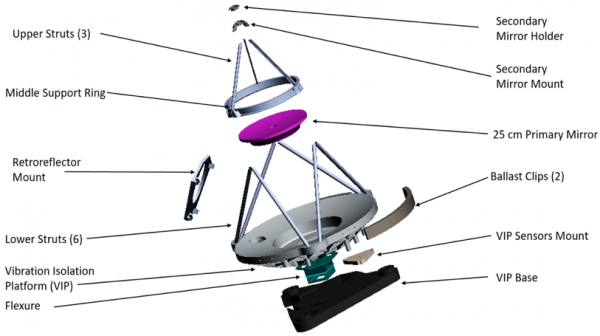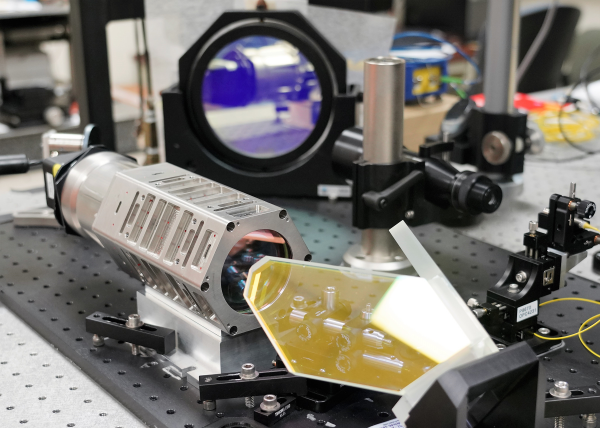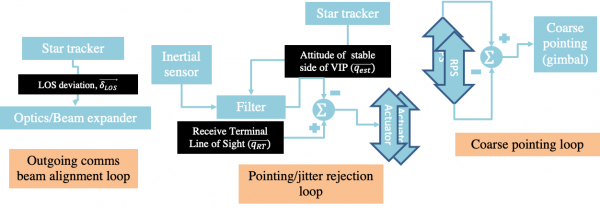Integrated Radio Optical Communication (iROC)
High-speed beaconless optical communications and proven radio-frequency technology
Integrated Radio Optical Communications (iROC)
The integrated Radio Optical Communications (iROC) terminal concept provides a hybrid radio-frequency (RF) and optical approach to space communications technology. By incorporating both radio and optical modes of communications into one single terminal, a high-level of communications system robustness will be achieved. The hybrid terminal concept provides reductions in Size Weight and Power (SWaP) compared to standard radio-only and optical-only terminals. Integrating a high-speed beaconless optical communications system with proven RF technology will create a fail-safe communications system that provides both a decrease in communications outages and a tremendous increase in data-rate throughput. Glenn Research Center leads iROC and has developed precision optics including primary, secondary and tertiary optics (See Figure 1), and is conducting system integration, testing and demonstration efforts. In support of the iROC terminal development Glenn is, with its commercial partners, co-developing interferometric star trackers suitable for novel beaconless pointing system architectures, compact, lightweight vibration isolation platforms and RF transparent Silicon Carbide.
|
|
Progression of the iROC Project
The iROC terminal was originally designed to support a Martian communications relay mission, similar to the Mars Reconnaissance Orbiter. The iROC terminal design capabilities have recently been expanded with a recent variant reoriented to support lunar missions.
The iROC terminal design is extensible from lunar applications to Mars missions and to missions that extend well beyond Mars.

Under the Space Technology Mission Directorate (STMD) Game Changing Development (GCD) program the iROC project will move the Technology Readiness Level (TRL) of the Martian version of iROC from 3 to 5 in preparation for a transition to flight demonstration. Under the STMD GCD program beaconless pointing technology will be demonstrated (to within the ability limited by astronomical seeing) with sufficient accuracy to support high-rate (100s of Mb/s) optical communications at planetary ranges.
Technology Developments
The iROC project incorporates a number of technology development areas that enable hybrid RF (32 GHz) and optical (1550 nm) space communications while minimizing mass. The terminal uses a special telescope/antenna system, or ‘teletenna’, where both radio and optical waves are effectively focused and transmitted towards receivers on Earth. See Figure 2. Construction of the flight version of the teletenna is accomplished through the use of specially doped Silicon Carbide (SiC) material that passes RF energy without significant loss of signal power. SiC is a material that is frequently used in fabricating space telescopes due to is material properties. The use of low-loss RF SiC helps enable the hybrid aperture design of the iROC terminal as the structure of the telescope will interfere with the RF waves to a significantly smaller extent than is normally encountered with metal structures. The choice to form the iROC structure exclusively from SiC provides an effective athermalization strategy for the iROC terminal.
The iROC system achieves stabilization and pointing of the optical beam without the aid of an uplink beacon from an Earth-based optical receiving telescope. Beaconless pointing of space borne optical communications systems with small divergence angle beams has not, yet, been demonstrated. As opposed to previous approaches to beaconless pointing the beaconless system developed for the iROC terminal employs a single sensor for attitude sensing and for registration of the Communications Beam Line-of Sight (CBLOS) to the attitude estimate. This iROC concept avoids the complex optical metrology systems that limit robustness in competing approaches. As part of this system development, the iROC project maturing, adapting and integrating high accuracy/low SWaP interferometric Star Tracker (iST) technology. See Figure 3.

A third significant technology development area for iROC is the Compact Lightweight Isolation Platform (CLIP). The CLIP provides platform stabilization and fine pointing of the optical system. This is critical as platform stabilization significantly reduces the motion between primary and secondary optics brought by spacecraft vibration. The modestly-sized optical elements of the iROC terminal enable a “platform stabilization” approach to beam stabilization and fine pointing in which the entire optical system is isolated from spacecraft vibration. The decrease in motion between primary and secondary optics brought by platform stabilization reduces requirements on optical system structure stiffness which, in turn, allows the optical system structure to be sparse and lightweight. Further weight reduction in the iROC is brought by the use of extremely small MagnetoHydroDynamic (MHD) rate gyro technology that is part of the CLIP system.

The sparseness of the telescope structure reduces RF blockages. Platform stabilization enables simplification and decoupling of the various control loops within the terminal. See Figure 4.
iROC Collaborators
NASA has spun-out several technology areas developed through iROC into separate projects, including the High-Rate Delay-Tolerant Network (HDTN) project and the Real Time Optical Receiver (RealTOR) project. Many of the technology developments stemmed from iROC have been achieved through the use of NASA SBIR funding. The iROC terminal is being developed with contributions from a number of small and medium business, including: Optical Physics Corporation (Simi Valley, CA) for the iST, Applied Technology Associates (Albuquerque, NM) for Vibration Isolation/Disturbance Free Platform technology and Xinetics (Cambridge, MA) for SiC technology.
